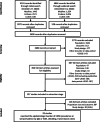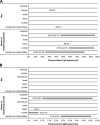A systematic literature review of the global seroprevalence of cytomegalovirus: possible implications for treatment, screening, and vaccine development
- PMID: 36050659
- PMCID: PMC9435408
- DOI: 10.1186/s12889-022-13971-7
A systematic literature review of the global seroprevalence of cytomegalovirus: possible implications for treatment, screening, and vaccine development
Abstract
Background: Cytomegalovirus (CMV) is a common pathogen that affects individuals of all ages and establishes lifelong latency. Although CMV is typically asymptomatic in healthy individuals, infection during pregnancy or in immunocompromised individuals can cause severe disease. Currently, treatments are limited, with no prophylactic vaccine available. Knowledge of the current epidemiologic burden of CMV is necessary to understand the need for treatment and prevention. A systematic literature review (SLR) was conducted to describe the most recent epidemiologic burden of CMV globally.
Methods: Medline, Embase, and LILACS were searched to identify data on CMV prevalence, seroprevalence, shedding, and transmission rates. The SLR covered the time period of 2010-2020 and focused geographically on Australia, Europe, Israel, Japan, Latin America (LATAM), and North America. Studies were excluded if they were systematic or narrative reviews, abstracts, case series, letters, or correspondence. Studies with sample sizes < 100 were excluded to focus on studies with higher quality of data.
Results: Twenty-nine studies were included. Among adult men, CMV immunoglobulin G (IgG) seroprevalence ranged from 39.3% (France) to 48.0% (United States). Among women of reproductive age in Europe, Japan, LATAM, and North America, CMV IgG seroprevalence was 45.6-95.7%, 60.2%, 58.3-94.5%, and 24.6-81.0%, respectively. Seroprevalence increased with age and was lower in developed than developing countries, but data were limited. No studies of CMV immunoglobulin M (IgM) seroprevalence among men were identified. Among women of reproductive age, CMV IgM seroprevalence was heterogenous across Europe (1.0-4.6%), North America (2.3-4.5%), Japan (0.8%), and LATAM (0-0.7%). CMV seroprevalence correlated with race, ethnicity, socioeconomic status, and education level. CMV shedding ranged between 0% and 70.2% depending on age group. No findings on CMV transmission rates were identified.
Conclusions: Certain populations and regions are at a substantially higher risk of CMV infection. The extensive epidemiologic burden of CMV calls for increased efforts in the research and development of vaccines and treatments.
Trial registration: N/A.
Keywords: CMV; Congenital cytomegalovirus; Cytomegalovirus; Epidemiology; Prevalence; Seroprevalence; Shedding.
© 2022. The Author(s).
Conflict of interest statement
AN, CT, JD-D, and PB are employees of Moderna, Inc. and hold stock/stock options in the company. ES, JM, MG, MK, MN, and WL are employees of Certara and were paid consultants for Moderna, Inc. for conduct of this research and development of the manuscript.
Figures



References
-
- Centers for Disease Control and Prevention . Cytomegalovirus (CMV) and Congenital CMV Infection - Clinical Overview. 2020.
-
- Taylor GH. Cytomegalovirus. Am Fam Physician. 2003;67(3):519–524. - PubMed
Publication types
MeSH terms
Substances
LinkOut - more resources
Full Text Sources
Other Literature Sources
Medical

